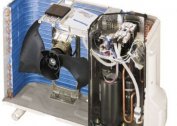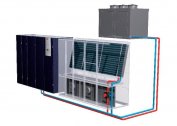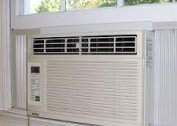The buyer’s attention is focused not only on the assortment and quality of the goods, but also on the microclimate of the retail space. To maintain a comfortable stay, the air should be clean, not too cold or hot. It is important to be sure that the money spent on the ventilation system of a store or shopping center is not in vain invested.
Air conditioning requirements
 In most large shopping centers, heating, ventilation and air conditioning systems are combined with each other. The building houses powerful ventilation systems having a heating and cooling section that can distribute air into the premises through air ducts.
In most large shopping centers, heating, ventilation and air conditioning systems are combined with each other. The building houses powerful ventilation systems having a heating and cooling section that can distribute air into the premises through air ducts.
Often, the role of a ventilation installation in a shopping center is played by a roof air conditioner (rooftop). It differs from the supply unit in that it is equipped with a monoblock chiller. The roof air conditioner is able to take air from the room, and then cool or heat it and feed it back.
In the “rooftop” fresh street air masses are mixed with the processed air. Their volume is calculated on the basis of sanitary standards:
- 20 m3 / h per visitor.
- 60 m3 / h per employee of the shopping center.
The total volume of gas (80 m3 / h) is thrown from the premises into the street, which allows maintaining the balance of air masses.
In summer, the roof air conditioner cools the air thanks to the freon circuit, and in winter it heats with a gas or water heater.
Often, instead of roof air conditioners, forced ventilation is installed with a water cooling and heating section. To heat the premises, hot water (90-130 degrees) from the boiler room enters the heating section. Chilled fluid (7 degrees) is transported from the chiller.
Types of climate systems for shopping centers
Among the common types of air conditioning of shopping centers, split systems, multi-split, and chiller-fan coil systems are distinguished.
Shopping center air conditioning with split systems
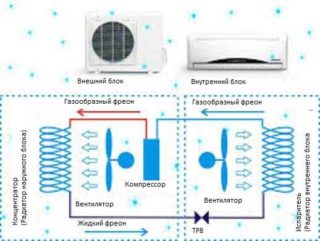 This type of air conditioning is rarely used for shopping centers, as it is suitable for rooms with a small area. In shopping centers, central systems are usually installed, which is justified from a design point of view - a lot of external air conditioning units look inappropriate on the storefront.
This type of air conditioning is rarely used for shopping centers, as it is suitable for rooms with a small area. In shopping centers, central systems are usually installed, which is justified from a design point of view - a lot of external air conditioning units look inappropriate on the storefront.
Split systems are applicable for budget shopping centers that are redeveloped from public buildings. Their common use is air conditioning in a boutique located on the ground floor of a residential building.
Advantages of air conditioning with split systems:
- Low cost.
- Independence of equipment from other owners, which allows you to maintain optimal room temperature around the clock. This condition is especially important for grocery stores.
- The possibility of heating the premises to +10 - +15 degrees, while maintaining a comfortable temperature in the off-season.
- The presence of additional functions - filtration, air ionization.
These advantages of using split systems ensure their popularity when equipping inexpensive shopping centers.
Using multi-split systems
Many indoor units are connected to one external, which allows not to install a lot of extra modules on the facade. There are 5-6 internal modules per one outdoor module.
This solution is suitable for cases when the indoor and outdoor units are installed at a great distance from each other.If the standard split system has a limit on the length of the highway at 15-20 m, then for multi-split this figure can reach 80-100 m.
Air conditioning boutique
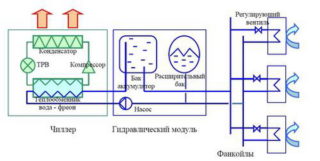 Most buildings of shopping centers are equipped with a refrigeration machine (chiller), and channels are laid directly into the boutique's premises. They are installed at the repair stage. Most often, channel fan coils are installed, which are mounted in a subceiling space.
Most buildings of shopping centers are equipped with a refrigeration machine (chiller), and channels are laid directly into the boutique's premises. They are installed at the repair stage. Most often, channel fan coils are installed, which are mounted in a subceiling space.
Ducts are parted above the room. They crash into the suspended ceiling at the points of installation of the ventilation grilles. Ducts for inflow and exhaust are also located in the inter-ceiling space.
Microclimate of small trading floors
The air conditioning system in the grocery store is selected taking into account many conditions - the number of refrigerators, the volume of the room, the number of employees, attendance, etc. Since the bulk of perishable products are placed in refrigeration units and freezers, it is impossible to select air conditioners according to standard characteristics. It is important to consider the heat dissipation of each refrigeration unit.
Ventilation of a store of industrial goods provides the minimum necessary one-time extraction of air masses from a commercial premises. This means that the system must throw out the volume of air that is contained in the room in one hour.
The capacity of the system for industrial goods stores is calculated on the basis of the maximum number of visitors, the area of a room, the placement of windows, the heat emission of devices and other factors.
Air conditioning and ventilation of multifunctional shopping centers
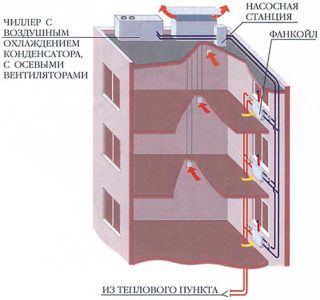 The main fundamental difference between multifunctional shopping centers is the multitude of premises for various purposes and volume. In such buildings, it will not be possible to use a combined ventilation and air conditioning system.
The main fundamental difference between multifunctional shopping centers is the multitude of premises for various purposes and volume. In such buildings, it will not be possible to use a combined ventilation and air conditioning system.
The classic system for multifunctional shopping centers is supply ventilation equipped with a cooling section. Air is supplied to all rooms in accordance with sanitary standards. The cooling section does not allow hot air from the street to enter the room. Through the hood, air is removed from the bathrooms, kitchens and premises of tenants.
To condition multifunctional shopping centers, chiller fan coils are used. The chiller prepares cold water and transports it to the fan coil units through pipes. The latter increase the temperature of the liquid to a predetermined value in each room.
At the stage of construction of modern multifunctional shopping centers, only the main equipment is mounted and the main communication networks are laid. Tenants install in their premises air ducts and grilles, fan coils, etc.
To condition small shopping centers, tenants are provided with cold water connection points.
Saving on climate equipment for the developer
When installing air conditioning systems in shopping centers, the shell & core scheme is gaining more and more popularity. This is the condition of the premises “for decoration” when only the main equipment is installed.
Benefits of the shell & core scheme:
- 10% energy savings for air conditioners compared to chiller fan coils.
- Reduced air conditioning costs by up to 30%.
Europeans call this system "stand-alone chillers for a water loop system." Instead of fan coils, each tenant installs an autonomous water-cooled mini-chiller in their premises. It contains a compressor with a freon circuit. Street temperature water is supplied to the miniciller. The air is cooled by a freon circuit, and heat from the room is transferred to water.
In shopping centers, an individual or standard air conditioning project is used. Typical systems are operated on the basis of a chiller-fan coil bundle. This system is suitable for single and multi-level buildings.If necessary, provide multi-zone air conditioning create an individual project. For this task, split systems, VRV and VRF circuits are used. As a result of their installation, each tenant can regulate the air flow in his premises.

